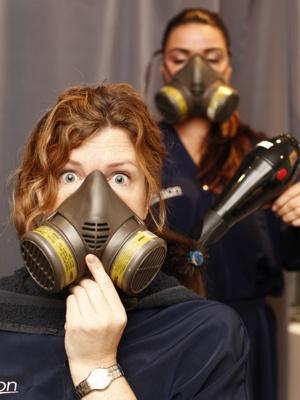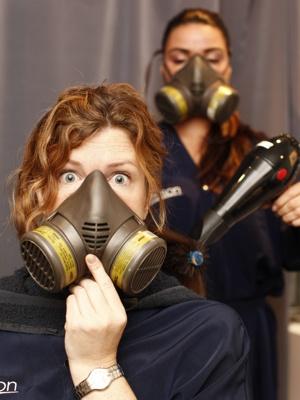Sipping coffee near her Union Square apartment, Alison Brower, 41, seems a pretty low-maintenance woman. In jeans, a T-shirt and flip-flops, the freelance editor admits to just one crazy beauty addiction: keratin treatments, also known by the popular brand-name Brazilian Blowout.
Brower got her first $350 treatment last year, before a trip to the Middle East and Italy, in order to save hair-styling time. The three-hour process endowed her with a mane of such silky smoothness, she was instantly hooked.
Months later she got the treatment again, and even though her eyes watered and she could feel chemicals in the back of her throat, she refused to quit. “I thought, ‘Well, this isn’t good, but now my hair never looks bad, and it’s hard to give it up,’ ” she says. “I have curly hair, and it used to take 40 minutes to blow out; now it takes 10 to 15 minutes. It’s got body and wave, but no frizz. As soon as it started to wear off, I wanted another one.”
Brower is hardly alone in her habit: Once someone has experienced the effortless freedom a keratin treatment brings, it’s as tough to give up as smoking. Even if it hurts you.
The treatment, which costs from $200 to $700 and lasts two to three months, has gotten a bad rap lately. Last year, the Occupational Safety and Health Administration warned that the formula used in Brazilian Blowouts contains nearly 10 times its stated level of toxic formaldehyde. In April, OSHA sent out another hazard alert, declaring that formaldehyde is linked to nose and lung cancer, especially when heated above 450 degrees. When hair is flat-ironed at the end of a “blowout,” chemicals vaporize — and are suddenly breathable.
In the wake of the warnings, some New York salons stopped offering keratin treatments completely, despite the enormous profits they delivered. Joel Warren, co-owner of Warren Tricomi Salons, which has two outposts in New York, says the company raked in about half a million dollars in revenue thanks to keratin last year. But it still banned the treatment in October.
“Clients were coughing and their eyes were tearing, and people on my staff were complaining of nose bleeds, headaches and sore throats,” says Warren. Other stylists now require clients to wear what looks like a wartime gas mask and goggles during the procedure. “Everyone who receives the treatment gets handed a mask with two canisters that looks like they’ve been air-dropped behind the borders of Libya,” says Mark Garrison, who owns a salon on the Upper East Side. He has also installed a special ventilation system and makes clients sign a release form.
“I tell them they do this at their own risk,” Garrison says. “All these mom-and-pop salons everywhere now offer keratin, and some use no precautions, or little paper masks meant for dust or paint. These women need their fix — that fix is no frizzy hair, and they are willing to put their lives on the line for it.”
That’s especially true in the summer, when high humidity zaps a woman’s crowning glory. The treatment first became popular four summers ago, before blowing up in 2009.
Cindy Barshop, 45, owner of the Completely Bare spas and the newest addition to “The Real Housewives of New York City,” is surprisingly blasé. She has been enjoying keratin treatments for more than five years and plans to continue, despite its bad press.
“Most everything turns out to be harmful, whether it’s deodorant or bottled water,” she shrugs.
“I try to live a healthy lifestyle, but my hair is frizzy, and I would totally do it again.” And yet the warnings have intensified. Earlier this month, the Department of Health and Human Services placed formaldehyde on a list of known carcinogens, and members of Congress have urged the FDA to recall the Brazilian Blowout hair-straightening treatment.
While many salons now promote “formaldehyde-free treatments,” even some of these solutions contain aldehyde or methylene glycol, both close cousins of the offending agent. “The company of the product I originally used [Coppola] told me it was formaldehyde-free, but it actually had aldehyde, and my throat was burned so badly that I was in the doctor’s chair for a year,” recalls salon owner Paul Labrecque of his early experience with keratin. He switched brands of keratin treatments and now also offers Liqwd Hair Straightener, which uses quinoa protein instead of formaldehyde.
Like Labrecque, many stylists are now turning to chemical-free straightening treatments. Though Garrison says the Brazilian Blowout was his salon’s biggest-ever financial success, he now provides safe alternatives, and says he won’t be sad to see keratin go. “Hopefully the FDA shuts it down,” he says. “Sure, I’ll lose money, but something else will come along.”
“Some of my clients are fighting with us,” adds Edward Tricomi of Warren Tricomi Salons. “The treatment was a godsend, but I feel it’s better to err on the side of caution until we find out more.”
But for some, keratin treatments are like a drug. No matter how bad the side effects are, you just want more. Even Marcy Siskind, 47, who has researched the effects of harmful chemicals in her job as a lawyer, refuses to go cold turkey.
“My hair is fine, wavy and frizzy — the trifecta of mess,” she sighs. “This treatment allows me to get out the door quickly and look presentable for work. Formaldehyde is not a terrific chemical, but you’re not exposed to it for long.”
Or, as Brower reasons: “I probably get more toxic fumes from walking behind a bus crossing 14th Street.” [NY Post] by Beth Landman



